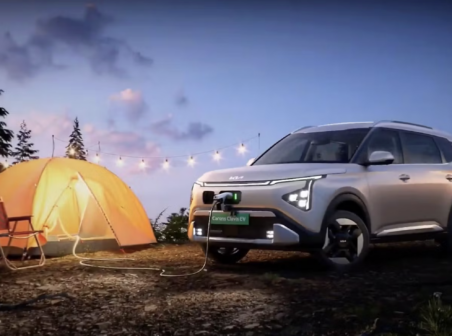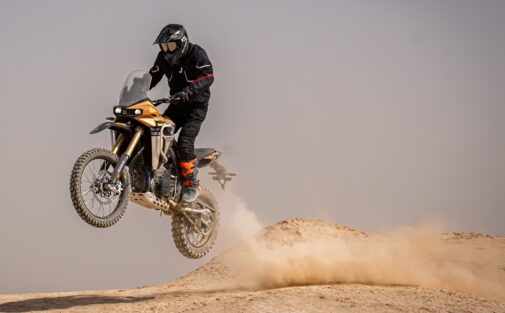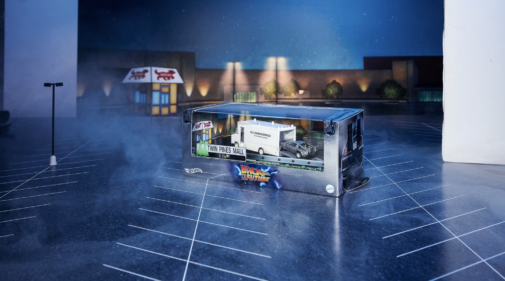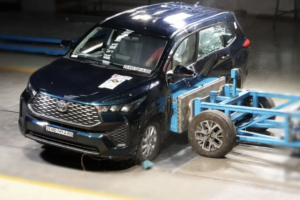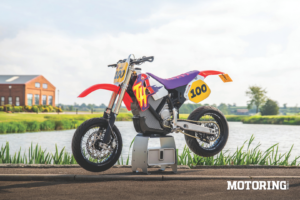History hangs in the air, as dense as fog. It’s bright and sunny, but cold. Cold enough for the only two crows in the vicinity to make a beeline for the chimneys that pour white smoke out into the freezing day. In the heated insides of the factory, it’s business as usual, empty spaces at the beginning of assembly lines transformed into complete motorcycles in the end. The faint hum of industrial machinery is suddenly conquered by the bark of a fast motorcycle waking up. A really fast motorcycle, actually. A newborn MotoGP bike, to be exact.
We’re standing at Suzuki’s Ryuyo test track, designed by Mitsuo Ito in the early 1960s. It’s a day before we’re to ride the new Gixxer SF, but that’s the last thing on my mind right now. Every time it occurs to me that every legendary Suzuki motorcycle, right from the original GSX-R750 to the Hayabusa, was tested here before being unleashed upon an unsuspecting world, the hairs on my arms give the place a standing ovation. Goosebumps of respect. And they stand taller still when the GSX-RR comes howling past. Bright blue motorcycles don’t get better than this.
It’s a beautiful way to spend a few hours, watching a MotoGP bike dance on sacred tarmac. It’s also a gut-wrenching reminder of the fact that I don’t, in fact, have the best job in the world. The big, white ‘Suzuki’ on the blue machine looks brilliant, even if a few letters are left to your imagination. And it’s a nice thing to see on the Gixxer SF, too.
It’s amazing how some things fall into place. For example, for the four days we’re in Japan, the weather is bright and sunny, if cold. Except, of course, on the day we’re supposed to ride. A rain-lashed, unfamiliar track is not something I look forward to. I’m pretty sure no sane person does. Damn this Pacific weather. And all of this for what is essentially the addition of a fairing to a motorcycle? Seems to be overkill, doesn’t it? It’s not, really. Because for once it’s not about the motorcycle.
This is about how Suzuki makes motorcycles. This is Suzuki getting back into the swing of things after a long pause that was brought about by an economic recession. It’s about the track, a glimpse into a guarded world that is Ryuyo. This is where Suzuki motorcycles are born, and there is something mighty reassuring about the fact that the Suzuki bikes we get in India are made at the same place that moulds a GSX-R1000. Here, in this rain-induced chilly gloom, the Gixxer SF looks like it belongs on this historic tarmac, in the company of giants. Surprising? Well, yes and no.
It really is just an addition of a fairing to what is already a fun motorcycle, so I can’t say much other than that it weighs 5 kg more, the exhaust has a different end cap made, I think, of aluminium, and the handlebar clamp is of a different design. The fairing itself looks pretty good, although I think the frontal area is more bulbous than necessary. It’s more Hayabusa than GSX-R, at least to me. And there’s a big area of black plastic on the inside, flanking the meter console. Nice place to put some clever stickers, though. Overall, the fairing doesn’t look like an add-on, and as is expected of Suzuki, everything feels well-built.
I step into the rain and get onto the bike, water trickling down my leather suit into all the wrong places. The lead rider is on a GSX-R1000, and I immediately feel sorry for him having to go much slower for our sakes. Turns out, at least I’m not going to be the reason for his continued misery for long. Two laps into the first session, I can’t wait to be back in the pit. I try going faster to distract myself from the cold, but overtaking isn’t allowed. My visor’s fogging up and I’m pretty sure that my right foot fell off a couple of corners ago because I can’t feel it anymore.
The Gixxer SF, in the meanwhile, is unmindful of the agony I’m going through and is quite up to the task of handling these conditions. Even on the extremely wet tarmac, it is superbly confident and never gives cause for worry. The tyres stick to the road, the suspension feels sorted through the high-speed corners, and the meter’s showing me 126 kph all along the main straight. Some of the lighter guys get it up to 130, even. So, thanks to the fairing, the Gixxer SF should have a higher top speed than its naked sibling. Cruising on highways should be easy, too, since the smooth motor is willing to sit at high revs all day, and the fairing that will send most of the wind over your head.
Now I don’t believe that adding a fairing to a motorcycle adds any real value to its capabilities, especially when it’s a 150cc bike. However, I have to admit that Suzuki has done a very smart thing by adding a full fairing and not a half/quarter number, because at this price (Rs 83,889, ex-showroom, Delhi), there is no full-faired bike in India. Also, it is still a refined, efficient and fun motorcycle, and the addition of a fairing is only going to add to its appeal in India. So you know why I think the Gixxer SF is going to do very well in our country. Indeed, I expect other manufacturers to follow suit, too. And I hope it won’t be long before Suzuki comes up with the next step – a bigger Zook to upgrade to from the Gixxer siblings. GSX-R300, anyone? I’d like a KTM-beating 400 better, though.
Honestly, it’s difficult to remain unimpressed when a motorcycle manufacturer as prolific as Suzuki throws open its doors for you. For a company that started out making power looms to pioneering practically every class of motorcycle that went on to become convention, Suzuki’s story is an impressive one. And today, with the renewed MotoGP effort, with a new Hayabusa in the works (‘We will beat the ZX-14R!’), with turbocharged middleweight motorcycles on the way, and with the Gixxer siblings in India, Suzuki is firmly shaking off the recession-induced sluggishness of which it was an unwilling subject. Big Blue, it seems, is back.
MOTODATA
SUZUKI GIXXER SF
POWERTRAIN
Displacement: 155cc, single cylinder
Max power: 14.6 bhp@8000 rpm
Max torque: 1.4 kgm@6000 rpm
Transmission: 5-speed
CHASSIS
Type: Single-downtube frame
SUSPENSION
(F/R): 41mm telescopic fork/monoshock
BRAKES
(F/R): Disc/drum
TYRES
(F/R): 100/80 R17 / 140/60 R17
DIMENSIONS
Wheelbase: 1330 mm
Kerb weight: 139 kg
Fuel tank: 12 litres
PRICE: Rs 83,889 (ex-showroom, Delhi)









